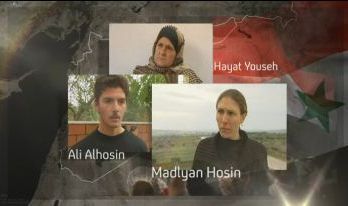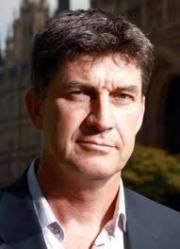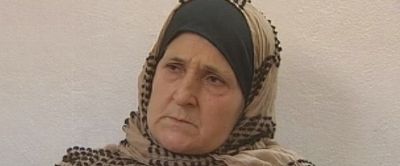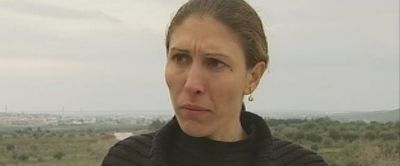
Publisher:
Bonnie King
CONTACT:
Newsroom@Salem-news.com
Advertising:
Adsales@Salem-news.com

~Truth~
~Justice~
~Peace~
TJP
Dec-16-2012 20:15

 TweetFollow @OregonNews
TweetFollow @OregonNews
Alex Thomson Report from Inside Syria - Was there a 'Massacre Committed by the Regime' in Aqrab?
Salem-News.comWe do not say what follows is the truth. But we can say it is the first independently observed story of Aqrab from the first outside journalist to reach this area.
 Special thanks to Silvia Cattori and Channel 4 News |
(AQRAB, Syria) - To reach Aqrab is to penetrate deep into the badlands of central Syria, where many of the worst atrocities of the war have taken place.
 Alex Thomson |
It is not a journey undertaken lightly, and 24 hours of intense planning were needed before we were able to drive west from the provincial capital, Hama.
Even then, an onboard escort was necessary, and we were passed from escort vehicle to escort vehicle across the patchwork of villages on the central fertile plains.
Local knowledge is very much the difference between life and death in a place where a wrong turn can mean the wrong people who find the wrong papers on you – with consequences that are all too often fatal.
So a drive of just 10 miles or so as the crow flies took us over an hour. And then, coming over yet another rocky ridge, there it was: Aqrab.
|
|
Eye-witness accounts
It’s a small place, and we were under a mile away. A low-rise, densely packed town of 9,000 Sunni and 2,000 Alawites. Three large minarets pierce the glowering winter skies here.
What follows is a series of eye-witness accounts which runs almost entirely against the version of what happened here which has gone global from rebel propaganda websites.
We do not say what follows is the truth. But we can say it is the first independently observed story of Aqrab from the first outside journalist to reach this area.
We interviewed three key eye-witnesses in three separate locations. They could not have known either of our sudden arrival, nor did they know the identities of the other two eye-witnesses.
What is striking is that their accounts entirely corroborate each other, to the last detail. And their accounts are further backed up by at least a dozen conversations with other Alawites who had fled from Aqrab.
Hayat Youseh is sheltering with relatives in a village some distance from Aqrab.
 |
Her husband is still in there. And her son, 18-year-old Ali Ibrahim, suffered a broken leg which went untreated for 12 days.
Ali al-Hosin is about 16 and clearly traumatised. He says both his parents and 23 members of his extended family are still trapped in there.
Madlyan Hosin is also close to tears. She says her four uncles and aunts are still in there, and two of the aunts are pregnant.
 |
'Not ‘normal Syrians
All three agree – as do the rebels – that rebels attacked Aqrab on Sunday 2 December. Madlyan says: “They had long beards. It was hard to understand what they said. They weren’t dressed like normal Syrians.”
I press her and she is adamant that their Arabic was not from Syria.
The youth Ali told us: “They all had big beards and came in four or five cars, from the direction of al-Houla.”
They all insist, as did everybody else we met, that the rebels from the Free Syrian Army (FSA) corralled around 500 Alawite civilians in a large red-coloured two-storey house belonging to a prominent businessman called Abu Ismail.
They then say they were held – around 500 men, women and children – in this building until the early hours of Tuesday 11 December. Nine days.
In that time they say almost no food was delivered, and women were hitting their own children to try and stop them crying. When it rained, they were holding rags out of the window to soak up and drink the moisture.
Hayat says that the rebels told everybody: “We are your brothers from al-Houla and al-Rastan, your Islamic brothers. We won’t hurt you.”
Both these towns are rebel strongholds. Al-Houla, just five miles away, is the scene of a notorious massacre in May of 108 civilians, mostly women and children.
They say the rebels wanted to take the women and children to al-Houla to use them as human shields against bombardment from government forces, and they believed they would kill the remaining men.
They all agree matters came to a head when a delegation of villagers was sent on Monday at 4pm to break the deadlock. In that delegation were a retired senior army officer, Hamid Azzudin, the town’s Sunni imam, Sheikh Sayid Hawash, and also Hashab, the town mayor.
When they arrived, the prisoners would not let them leave. As Ali puts it: “Once they came into the house, we just said, ‘We all go together, men women and children – or we all die together.’”
It appears negotiations ran between these elders and the rebels for around four hours, ending in deadlock at around eight o’clock on Monday night.
At that point, shooting broke out, the rebels firing through the windows and shouting that they had booby-trapped the building. The eye-witnesses say that the shooting died down at about midnight, after which a deal was done. In screaming night-time chaos and intermittent shooting, three vehicles took around 70 of the prisoners to safety in the nearest village a mile away.
However, it seems a fourth vehicle took a number of prisoners to al-Houla, where two – an unidentified woman and a boy – were treated for injuries in a rebel field hospital.
The woman and boy blamed pro-government militia for taking the prisoners, according to rebel websites, and that is the version of events which has gone around the world.
Until now.
Our witnesses, however, were interviewed independently of each other and are prepared to give their names and appear on global television.
Curiously, rebel websites say the building containing the prisoners who remained, was completely destroyed by government artillery and air strikes on Tuesday. However, we saw and filmed the building in which eye-witnesses said they were imprisoned, and it appears intact – as does the rest of the village.
Another curious observation. If you check rebel websites and their YouTube videos, from 2 December onwards, there appears to be no mention of a large number of Alawites being held in the village. This appears an unusual omission for what would presumably be an enormous propaganda coup.
Another curiosity is that their version of events doesn’t explain why government officials in Hama are frantically negotiating the release of prisoners, wounded people and, indeed, bodies from a stand-off which they say is still going on right now.
And another thing to ponder. Invariably when there’s a massacre, the rebels put the bodies out on YouTube and make a song and dance about it. If the government really did massacre up to 250 people from President Assad’s own Alawite sect, YouTube would be 10 feet deep in rebel videos, of the bodies, of the funerals, of the carnage. Be in no doubt about this. Yet check on YouTube – there is not a scrap of video to back their story.
Both sides talk of what would be the biggest massacre of Alawites of this war. They are, of course, the same sect as President Bashar al-Assad. The rebels have put their version of the story out, saying between 200 and 250 people were killed when the government bombed that house on Tuesday.
Fearing for their lives, government officials will not comment on camera, but they are convinced a major massacre has happened here after the lucky few broke free early on Tuesday morning.
One group of people can unlock one dispute here, and that is the Red Crescent, who gained access to the prisoners nine days into the stand-off. They know for sure whether it was government militia or rebels holding those people. However, this is a dangerous place, and so far the Red Crescent have made no comment.
Alex Thomson
blogs.channel4.com, December 14, 2012
In June 2012, Alex Thomson’s vehicle, in which he and his Channel 4 News colleagues were traveling, came under fire with his team from a Free Syrian Army group that intentionally attempted to have the team killed on no-man’s land by the government forces as a propagandistic stunt against Damascus.
See: http://www.silviacattori.net/article3298.html
Post scriptum
Those who speak Arabic can see the report made by Al-Mayadeen television, (directed by Ghassan Bin Jiddo, the great and honest Tunisian journalist who resigned from Aljazeera) in Central Syria, near the village.
- Y a-t-il eu un massacre dans la ville syrienne d’Aqrab ?
Special thanks to Silvia Cattori, Alex Thomson and Channel 4 News
 |
 |
 |
Articles for December 15, 2012 | Articles for December 16, 2012 | Articles for December 17, 2012

Quick Links
DINING
Willamette UniversityGoudy Commons Cafe
Dine on the Queen
Willamette Queen Sternwheeler
MUST SEE SALEM
Oregon Capitol ToursCapitol History Gateway
Willamette River Ride
Willamette Queen Sternwheeler
Historic Home Tours:
Deepwood Museum
The Bush House
Gaiety Hollow Garden
AUCTIONS - APPRAISALS
Auction Masters & AppraisalsCONSTRUCTION SERVICES
Roofing and ContractingSheridan, Ore.
ONLINE SHOPPING
Special Occasion DressesAdvertise with Salem-News
Contact:AdSales@Salem-News.com




Terms of Service | Privacy Policy
All comments and messages are approved by people and self promotional links or unacceptable comments are denied.
[Return to Top]
©2025 Salem-News.com. All opinions expressed in this article are those of the author and do not necessarily reflect those of Salem-News.com.